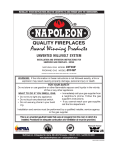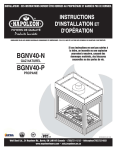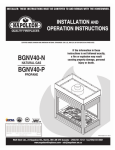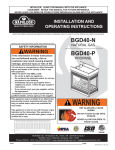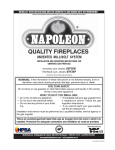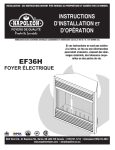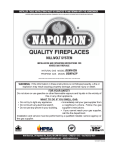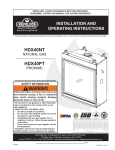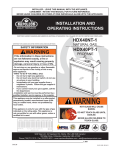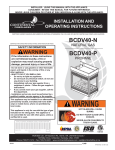Download Napoleon Fireplaces fireplaces User's Manual
Transcript
1 W415-0319 / E / 01.17.07 2 TABLE of CONTENTS PG 3-4 INTRODUCTION Hood Louvre Bracket Hinge Screen Louvre Installation & Removal Heat Shield Stand Off Removal Logo Placement Warranty General Instructions General Information Care of Glass Doors, Catalytic Tiles & Plated Parts 5-12 INSTALLATION 16-17 OPTIONS Combustion and Ventilation Air Provisions Determining Confined or Unconfined Space Gas Installation Framing Dimensions Peninsula Installation Procedure Open End Installation Procedure See-Thru Installation Procedure Island Installation Procedure 13-15 FINISHING Log Placement Glowing Embers Charcoal Embers Mantle Installation Curtain Mesh Patented Catalytic Glass Door Blower Installation 18-19 OPERATION / MAINTENANCE Operating Instructions Maintenance Catalytic Tile Maintenance Oxygen Depletion Sensor Pilot Cleaning Pilot Flame Appearance Venturi Adjustment 20-21 REPLACEMENTS Ordering Replacement Parts Replacement Parts 22-23 TROUBLE SHOOTING GUIDE PLEASE RETAIN THIS MANUAL FOR FUTURE REFERENCE WARNING • Under no circumstances should this heater be modified. • Provide adequate ventilation and combustion air. Provide adequate accessibility clearance for servicing and operating the heater. Never obstruct the front opening of the heater. • If heater shuts off, do not re-light until you provide fresh air. If heater keeps shutting off, have it serviced. Keep burner and control compartment clean. • Do not burn wood or other materials in this heater. • Adults and especially children should be alerted to the hazards of high surface temperatures and should stay away to avoid burns or clothing ignition. Keep young children and animals away when the fireplace is hot. • Due to high temperatures, the heater should be located out of traffic and away from furniture and draperies. • Clothing or other flammable material should not be placed on or near the heater. • Any safety screen or guard removed for servicing must be replaced prior to operating the heater. • It is imperative that the control compartments, burners and circulating air passageways in the heater are kept clean. The heater should be inspected before use and at least annually by a qualified service person. More frequent cleaning may be required due to excessive lint from carpeting, bedding material, etc. The heater area must be kept clear and free from combustible materials, gasoline and other flammable vapours and liquids. • Furniture or other objects must be kept a minimum of 4 feet away from the front of the fireplace. • Do not use this heater if any part has been under water. Immediately call a qualified service technician to inspect the heater and to replace any part of the control system and any gas control which has been under water. • Do not allow fans to blow directly into the fireplace. Avoid any drafts that alter burner flame patterns. • Do not use a blower insert, heat exchanger insert or other accessory not approved for use with this heater. ANY CHANGE TO THIS HEATER OR ITS CONTROLS CAN BE DANGEROUS AND IS PROHIBITED. NOTE: CHANGES, OTHER THAN EDITORIAL, ARE DENOTED BY A VERTICAL LINE IN THE MARGIN W415-0319 / E / 01.17.07 3 WARNING: If the information in these instructions is not followed exactly, a fire or explosion may result causing property damage, personal injury or death. FOR YOUR SAFETY Do not store or use gasoline or other flammable vapours and liquids in the vicinity of this or any other appliance. WHAT TO DO IF YOU SMELL GAS: • Immediately call your gas supplier from a • Do not try to light any appliance. neighbour's phone. Follow the gas supplier's in• Do not touch any electrical switch. structions. • Do not use any phone in your build • If you cannot reach your gas supplier, call the ing. fire department. Installation and service must be performed by a qualified installer, service agency or the gas supplier. This is an unvented gas-fired heater that uses air (oxygen) from the room in which it is installed. Provisions for adequate combustion and ventilation air must be provided. NAPOLEON gas fireplaces are manufactured under the strict Standard of the world recognized ISO 9001 : 2000 Quality Assurance Certificate. NAPOLEON products are designed with superior components and materials, assembled by trained craftsmen who take great pride in their work. The burner and valve assembly are leak and test-fired at a quality test station. The complete fireplace is test-fired and thoroughly inspected by a qualified technician before packaging to ensure that you, the customer, receives the quality product that you expect from NAPOLEON. NAPOLEON GAS FIREPLACE PRESIDENT'S LIFETIME LIMITED WARRANTY The following materials and workmanship in your new NAPOLEON gas fireplace are warranted against defects for as long as you own the fireplace. This covers: combustion chamber, heat exchanger, stainless steel burner, phazer™ logs and embers, ceramic glass (thermal breakage only), gold plated parts against tarnishing, porcelainized enamelled components and aluminum extrusion trims. Electrical (110V and millivolt) components and wearable parts such as catalytic tiles, blowers, gas valves, thermal switch, switches, wiring, remote controls, ignitor, gasketing, and pilot assembly are covered and NAPOLEON will provide replacement parts free of charge during the first year of the limited warranty. Labour related to warranty repair is covered free of charge during the first year. Repair work, however, requires the prior approval of an authorized company official. Labour costs to the account of NAPOLEON are based on a predetermined rate schedule and any repair work must be done through an authorized NAPOLEON dealer. CONDITIONS AND LIMITATIONS NAPOLEON warrants its products against manufacturing defects to the original purchaser only -- i.e., the individual or legal entity (registered customer) whose name appears on the warranty registration card filed with NAPOLEON -- provided that the purchase was made through an authorized NAPOLEON dealer and is subject to the following conditions and limitations: This factory warranty is nontransferable and may not be extended whatsoever by any of our representatives. The gas fireplace must be installed by a licenced, authorized service technician or contractor. Installation must be done in accordance with the installation instructions included with the product and all local and national building and fire codes. This limited warranty does not cover damages caused by misuse, lack of maintenance, accident, alterations, abuse or neglect and parts installed from other manufacturers will nullify this warranty. This limited warranty further does not cover any scratches, dents, corrosion or discolouring caused by excessive heat, abrasive and chemical cleaners nor chipping on porcelain enamel parts, mechanical breakage of PHAZER™ logs and embers, nor any venting components used in the installation of the fireplace. NAPOLEON warrants its stainless steel burners against defects in workmanship and material for life, subject to the following conditions: During the first 10 years NAPOLEON will replace or repair the defective parts at our option free of charge. From 10 years to life, NAPOLEON will provide replacement burners at 50% of the current retail price. In the first year only, this warranty extends to the repair or replacement of warranted parts which are defective in material or workmanship provided that the product has been operated in accordance with the operation instructions and under normal conditions. After the first year, with respect to this President's Limited Lifetime Warranty, NAPOLEON may, at its discretion, fully discharge all obligations with respect to this warranty by refunding to the original warranted purchaser the wholesale price of any warranted but defective part(s). After the first year, NAPOLEON will not be responsible for installation, labour or any other costs or expenses related to the reinstallation of a warranted part, and such expenses are not covered by this warranty. Notwithstanding any provisions contained in this President's Limited Lifetime Warranty, NAPOLEON’S responsibility under this warranty is defined as above and it shall not in any event extend to any incidental, consequential or indirect damages. This warranty defines the obligations and liability of NAPOLEON with respect to the NAPOLEON gas fireplace and any other warranties expressed or implied with respect to this product, its components or accessories are excluded. NAPOLEON neither assumes, nor authorizes any third party to assume, on its behalf, any other liabilities with respect to the sale of this product. NAPOLEON will not be responsible for: over-firing, downdrafts, spillage caused by environmental conditions such as rooftops, buildings, nearby trees, hills, mountains, inadequate vents or ventilation, excessive venting configurations, insufficient makeup air, or negative air pressures which may or may not be caused by mechanical systems such as exhaust fans, furnaces, clothes dryers, etc. Any damages to fireplace, combustion chamber, heat exchanger, brass trim or other component due to water, weather damage, long periods of dampness, condensation, damaging chemicals or cleaners will not be the responsibility of NAPOLEON. The bill of sale or copy will be required together with a serial number and a model number when making any warranty claims from your authorized dealer. The warranty registration card must be returned within fourteen days to register the warranty. NAPOLEON reserves the right to have its representative inspect any product or part thereof prior to honouring any warranty claim. ALL SPECIFICATIONS AND DESIGNS ARE SUBJECT TO CHANGE WITHOUT PRIOR NOTICE DUE TO ON-GOING PRODUCT IMPROVEMENTS. NAPOLEON® IS A REGISTERED TRADEMARK OF WOLF STEEL LTD. PATENTS U.S. 5.303.693.801 - CAN. 2.073.411, 2.082.915. © WOLF STEEL LTD. W415-0319 / E / 01.17.07 4 GENERAL INSTRUCTIONS THIS GAS FIREPLACE SHOULD BE INSTALLED AND SERVICED BY A QUALIFIED INSTALLER to conform with local codes. Installation practices vary from region to region and it is important to know the specifics that apply to your area, for example: in Massachusetts State: • The appliance off valve must be a “T” handle gas cock. • The flexible connector must not be longer than 36 inches. • The appliance is not approved for installation in a bedroom or bathroom unless the unit is a direct vent sealed combustion product. • A carbon monoxide detector is required in all rooms containing gas fired appliances. • WARNING: This product must be installed by a licensed plumber or gas fitter when installed within the commonwealth of Massachusetts. • Un-vented room heater shall be installed in accordance with 527 CMR 30.00 and 248 CMR 3.00 through 7.00. • Sellers of un-vented propane or natural gas-fired space/room heaters shall provide to each purchaser a copy of 527 CMR 30.00 upon the sale of the unit from http://www.napoleonfireplaces.com/Webshare/ installation_manuals/mass_requirements.pdf In absence of local codes, install the GVF40 to the current National Fuel Gas Code, ANSI Z223.1 Installation Code which can be obtained from: American Nation Standards Institute Inc. 1430 Broadway New York, NY 10018 or National Fire Protection Association Inc. Batterymarch Park Quincy, MA 02269 The fireplace and its individual shutoff valve must be disconnected from the gas supply piping system during any pressure testing of that system at test pressures in excess of 1/2 psig (3.5 kPa). The fireplace must be isolated from the gas supply piping system by closing its individual manual shutoff valve during any pressure testing of the gas supply piping system at test pressures equal to or less than 1/2 psig (3.5 kPa). When the fireplace is installed directly on carpeting, vinyl tile or other combustible material other than wood flooring, the fireplace shall be installed on a metal or wood panel extending the full width and depth. If the optional fan or blower is installed, the junction box must be electrically connected and grounded in accordance with local codes. In the absence of local codes, use the current ANSI/NFPA 70 NATIONAL ELECTRICAL CODE in the United States. GENERAL INFORMATION FOR YOUR SATISFACTION, THIS FIREPLACE HAS BEEN TEST-FIRED TO ASSURE ITS OPERATION AND QUALITY! Maximum input is 30,000 BTU/hr for natural gas and 28,500 BTU/hr for propane. When the fireplace is installed at elevations above 2,000ft, and in the absence of specific recommendations from the local authority having jurisdiction, the certified high altitude input rating shall be reduced at the rate of 4% for each additional 1,000ft. This heater must not be installed in a bedroom or bathroom. W415-0319 / E / 01.17.07 This fireplace may be installed in an aftermarket permanently located, manufactured (mobile) home, where not prohibited by local codes. This fireplace is only for use with the type of gas indicated on the rating plate. This fireplace is not convertible for use with other gases, unless a certified kit is used. Minimum inlet gas supply pressure is 4.5 inches water column for natural gas and 11 inches water column for propane. Maximum inlet gas pressure is 7 inches water column for natural gas and 13 inches water column for propane. Manifold pressure under flow conditions is 3.5 inches water column for natural gas and 10 inches water column for propane. No external electricity (110 volts or 24 volts) is required for the gas system operation. Expansion / contraction noises during heating up and cooling down cycles are normal and are to be expected. CARE OF OPTIONAL GLASS DOORS, CATALYTIC TILES AND PLATED PARTS Do not use abrasive cleaners to clean plated parts. Buff lightly with a clean dry cloth. This fireplace may have optional glass doors which are equipped with either 3/16" thick tempered or ceramic glass. Use only replacement glass available from your Napoleon dealer. DO NOT SUBSTITUTE MATERIALS. Clean the glass after the first 10 hours of operation with a recommended gas fireplace glass cleaner. Thereafter clean as required. DO NOT CLEAN GLASS WHEN HOT! If the glass is not kept clean permanent discolouration and / or blemishes may result. Catalytic tiles normally do not require cleaning. Physical contact should be avoided. See Maintenance. This heater is equipped with a pilot light safety system referred to as an OXYGEN DEPLETION SENSOR and is designed to turn off the heater if not enough fresh air is available. Use only accessories designed for and listed with your specific fireplace. CARBON MONOXIDE POISONING MAY LEAD TO DEATH Early signs of carbon monoxide poisoning resemble the flu, with headache, dizziness and/ or nausea. If you have these signs, the heater may not be working properly. Get fresh air at once! Have heater serviced. Some people---pregnant women, persons with heart or lung disease, anaemia, those under the influence of alcohol, those at high altitudes--- are more affected by carbon monoxide than others. 5 INSTALLATION COMBUSTION AND VENTILATION AIR PROVISIONS This heater shall not be installed in a confined space or unusually tight construction unless provisions are provided for adequate combustion and ventilation air. In order to avoid the possibility of exposed insulation or vapour barrier coming in contact with the fireplace body, it is recommended that the walls of the fireplace enclosure be 'finished', (i.e. drywall/sheetrock) as would any other outside wall of the home. This will ensure that clearance to combustibles is maintained within the cavity. The National Fuel Gas Code, ANSI Z223.1 defines a confined space as a space whose volume is less than 50 cubic feet per 1,000 Btu per hour (4.8 m3 per kW) of the aggregate input rating of all appliances installed in that space and an unconfined space as a space whose volume is not less than 50 cubic feet per 1,000 BTU per hour (4.8 m3 per kW) of the aggregate input rating of all appliances installed in that space. Rooms communicating directly with the space in which the appliances are installed, through openings not furnished with doors are considered a part of the unconfined space. The GVF40 is rated at 30,000BTUs per hour for natural gas and 28,500 BTUs for propane and therefore requires a minimum unconfined space of 1,500 and 1,425 cubic feet respectively. DETERMINING CONFINED OR UNCONFINED SPACE Unusually tight construction is defined as construction where: a) Walls and ceilings exposed to the outside atmosphere have a continuous water vapour retarder with a rating of 1 perm (6 x 10-11 kg per pa-sec-m2) or less with openings gasketed or sealed, and b) Weather stripping has been added on openable windows and doors, and c) Caulking or sealants are applied to areas such as joints around window and door frames, between sole plates and floors, between wall-ceiling joints, between wall panels, at penetrations for plumbing, electrical, and gas lines, and at other openings. An unvented room heater is recommended for use as a secondary heat source rather than as a primary source. Gas combustion produces water vapour which could occur at the rate of approximately one ounce of water for every 1,000 BTU/hr of gas input. During the cold weather season, indoor humidity levels tend to be low. Consequently, this water vapour can enhance the living space. However if a problem should occur: a) ensure sufficient combustion and circulation air b) use a dehumidifier c) do not use the unvented room heater as a primary heat source Without sufficient fresh air for proper operation, poor fuel combustion can result. Carbon Monoxide is a result of poor combustion. If additional fresh air is required, use one of the methods described in the National Fuel Gas Code, ANSI Z223.1, Section 5.3 or the applicable local code. To determine the volume of the room where the heater is to be installed, multiply the width x the length x the ceiling height of that room measured in feet. If any adjoining rooms are connected by grills or openings such as kitchen passthroughs, etc., the volume of those rooms may be added to the total. Multiply the room volume by 1000 and divide this amount by 50 to determine the maximum Btu/hr that the space can support with adequate combustion and ventilation air. Add the BTU/hr of all fuel burning appliances located within the space such as gas furnace, gas water heater, etc. Do not include direct vent gas appliances which draw their input and output air from and to the outdoors. WARNING: If the area in which the heater may be operated is smaller than that defined as an unconfined space or if the building is of unusually tight construction, provide adequate combustion and ventilation air by one of the methods described in the National Fuel Gas Code ANSI Z223.1, Section 5.3 or the applicable local code. W415-0319 / E / 01.17.07 6 FIGURE 1 ROOM 2 ROOM 1 HEIGHT W LENGTH ID H T If for example, the length of the rooms is 10 feet, the width of Room 1 is 10 feet, the width of Room 2 is 15 feet the height of the rooms is 8 feet. The volume of Room 1: 10 x 10 x 8 = 800 cubic feet. The volume of Room 2: 10 x 15 x 8 = 1200 cubic feet. Room Volume = Length x Width x Height Max BTU/hr = Room Volume x 1000 ÷ 50 EXAMPLE 1 EXAMPLE 2 In this example, because there is no door to the adjoining room, the volume of the adjoining room may be added to the volume of the room with the heater to get a total unconfined space. If in this example a solid door separates Room 1 from Room 2, the volume of Room 2 could not be used. In this case the maximum BTU/h would be: The total unconfined space: 800 + 1200 = 2000 cubic feet. Maximum BTU/h: 2000 x 1000 50 = 40,000 BTU/h If there are no more fuel burning appliances within this space then the 30,000 BTU/h input of the fireplace is suitable to be installed. This also assumes that the construction of this space is not unusually tight. Maximum BTU/h: 800 x 1000 50 = 16,000 BTU/h This would be considered a confined space since it can not support the 30,000BTU/h input of the heater and it would be necessary to provide adequate combustion and ventilation air to Room 1. GAS INSTALLATION 5. Attach the two leads to terminals 1 and 3 located on the gas valve. O ON PLT FIGURE 3 1 2 LO DO NOT KINK FLEX CONNECTOR. MAX. LENGTH 100 feet 60 feet 40 feet FF FIGURE 2 WIRE SIZE 14gauge 16gauge 18gauge IH 1. Move the fireplace into position and secure to the floor through the ¼"ø holes located at the four outside corners of the base. 2. Install rigid black pipe, 1/2" type-L copper tubing or, if local codes permit, a 3/8" flex connector and shutoff valve to the gas line and the fireplace gas valve. Seal and tighten securely. An adapter fitting is required between the gas valve and the copper tubing or flex connector. O I 3. Check for gas leaks by brushing on a soap and water solution. DO NOT USE OPEN FLAME. 4. For ease of accessibility, an optional remote wall switch or millivolt thermostat may be installed in a convenient location. Route a 2 strand, solid core millivolt wire through the electrical hole located at the bottom left side of the unit. The recommended maximum lead length depends on wire size: W415-0319 / E / 01.17.07 PI L OT 3 Do not connect either the wall switch, thermostat or gas valve to electricity (110 volts). 6. Mark the appropriate boxes on the rating plate label to indicate the model type. USING DOOR OPTION: Purge all gas lines with the glass door of the fireplace opened. Assure that a continuous gas flow is at the burner before closing the door. 7 4-SIDED FIGURES 4 a-d SEE-THRU OPEN-END PENINSULA W415-0319 / E / 01.17.07 8 PENINSULA INSTALLATION PROCEDURE FRAMING COUNTERTOP / BAR INSTALLATION Note: In order to avoid the possibility of exposed insulation or vapour barrier coming in contact with the fireplace body, it is recommended that the walls of the fireplace enclosure be “finished” (ie: drywall/sheetrock), as you would finish any other outside wall of a home. This will ensure that clearance to combustibles is maintained within the cavity. It is best to frame your fireplace after it is positioned. Use 2x4's and frame to local building codes. FIGURE 5. When finishing the fireplace, combustible material may rest directly on of the top extension. Note: Maximum weight tolerance is 400 lbs, provided that it is evenly distributed across the top extensions of the fireplace. In order to achieve a countertop or bar type appearance with the minimum height allowed, framing must be noncombustible and may be done with metal studding attached to the heat shield sides or the upper frame of the fireplace. FIGURE 7. A FIGURE 5 FIGURE 7 A = 22 " minus finishing material thickness each side. To install the fireplace face flush with the finished wall, position the framework to accommodate the thickness of the finished wall. FIGURE 6 * The top extension may be removed if non-combustible framing is faced with a non-combustible material placed flush with the front face of the unit and extending from the top of the unit. (Example: cement board) (not supplied). Combustible counter / bar tops must maintain a minimum of 38 inches from the base of the fireplace to the underside of the top. Figure 8. FIGURE 8 TOP EXTENTION TOP OF THE UNIT NOTE: Wolf Steel trim and/or surround kits will not totally cover the top extension of the fireplace. In order to obtain a smooth transition from the trim / surround to the wall, it is recommended that the top extension be removed and the unit be installed following the above procedure. W415-0319 / E / 01.17.07 9 BRICK PANEL INSTALLATION FACING Install the base panels as illustrated in steps 1-4 . The side panel sits under the bracket tab. Holding the side panel in position, bend down the tab to secure. [DETAIL 5.] Combustible materials may be installed flush with the front of the fireplace but must not cover any of the black faceareas of the fireplace. Non-combustible material (brick, stone or ceramic tile) may protrude in these areas. It is not necessary to install a hearth extension with this fireplace system. FIGURES 9a-e STEP 1 When roughing in the fireplace, raise the fireplace to accommodate for the thickness of the finished floor materials, i.e. tile, carpeting, hard wood, which if not planned for will interfere with the opening of the lower access door and the installation of many decorative flashing accessories. Objects placed in front of the fireplace should be kept a minimum of 48" away from the glass front faces of the fireplace. FIGURE 10 STEP 2 DRYWALL DRYWALL STEP 3 4" MIN STEP 4 FINISHING Refer to pages 13-15 for complete instructions regarding mantle requirements and installations, log placement, glass door and upper and lower louvre attachments. RETAINER STEP 5 DETAIL 5 W415-0319 / E / 01.17.07 10 OPEN-END INSTALLATION PROCEDURE FRAMING Note: In order to avoid the possibility of exposed insulation or vapour barrier coming in contact with the fireplace body, it is recommended that the walls of the fireplace enclosure be “finished” (ie: drywall/sheetrock), as you would finish any other outside wall of a home. This will ensure that clearance to combustibles is maintained within the cavity. It is best to frame your fireplace after it is positioned and the vent system is installed. Use 2x4's and frame to local building codes. FIGURE 11. See PAGE 8 for bar type / countertop installation. FIGURES 13 a-c STEP 5 FIGURE 11 RETAINER IH O LO O FF P L DETAIL 6 STEP 6 FACING FIGURE 12 Combustible materials may be installed flush with the front of the fireplace but must not cover any of the black faceareas of the fireplace. Non-combustible material (brick, stone or ceramic tile) may protrude in these areas. It is not necessary to install a hearth extension with this fireplace system. When roughing in the fireplace, raise the fireplace to accommodate for the thickness of the finished floor materials, i.e. tile, carpeting, hard wood, which if not planned for will interfere with the opening of the lower access door and the installation of many decorative flashing accessories. Objects placed in front of the fireplace should be kept a minimum of 48" away from the glass front faces of the fireplace. A A = 25¼" minus finishing material thickness each side. NOTE: LEFT CORNER UNIT ILLUSTRATED To install the fireplace face flush with the finished wall, position the framework to accommodate the thickness of the finished wall. BRICK PANEL INSTALLATION Install the base panels as illustrated in steps 1-4 on page 9. The side panel sits under the bracket tab. Holding the side panel in position, bend down the tab to secure. [DETAIL 6]. W415-0319 / E / 01.17.07 FINISHING Refer to pages 13-15 for complete instructions regarding mantle requirements and installations, log placement, glass door and upper and lower louvre attachments. FIGURE 14 DRYWALL DRYWALL 4" MIN 11 SEE-THROUGH INSTALLATION PROCEDURE FRAMING FACING Note: In order to avoid the possibility of exposed insulation or vapour barrier coming in contact with the fireplace body, it is recommended that the walls of the fireplace enclosure be “finished” (ie: drywall/sheetrock), as you would finish any other outside wall of a home. This will ensure that clearance to combustibles is maintained within the cavity. It is best to frame your fireplace after it is positioned and the vent system is installed. Use 2x4's and frame to local building codes. FIGURE 15. See PAGE 8 for bar type / countertop installation. Combustible materials may be installed flush with the front of the fireplace but must not cover any of the black faceareas of the fireplace. Non-combustible material (brick, stone or ceramic tile) may protrude in these areas. It is not necessary to install a hearth extension with this fireplace system. When roughing in the fireplace, raise the fireplace to accommodate for the thickness of the finished floor materials, i.e. tile, carpeting, hard wood, which if not planned for will interfere with the opening of the lower access door and the installation of many decorative flashing accessories. FIGURE 15 Objects placed in front of the fireplace should be kept a minimum of 48" away from the glass front faces of the fireplace. FINISHING Refer to pages 13-15 for complete instructions regarding mantle requirements and installations, log placement, glass door and upper and lower louvre attachments. FIGURE 17 A DRYWALL DRYWALL A = 22" minus finishing material thickness, each side. BRICK PANEL INSTALLATION Install the base panels as illustrated in steps 1-4 on page 9. Both side panels sit under the bracket tab. Holding the side panel in position, bend down the tab to secure. [DETAIL 6]. FIGURES 16 a-c 4" MIN RETAINER STEP 5 DETAIL 5 & 6 RETAINER STEP 6 W415-0319 / E / 01.17.07 12 ISLAND INSTALLATION PROCEDURE FRAMING BRICK PANEL INSTALLATION Note: In order to avoid the possibility of exposed insulation or vapour barrier coming in contact with the fireplace body, it is recommended that the walls of the fireplace enclosure be “finished” (ie: drywall/sheetrock), as you would finish any other outside wall of a home. This will ensure that clearance to combustibles is maintained within the cavity. It is best to frame your fireplace after it is positioned. Use 2x4's and frame to local building codes. FIGURE 18. Install the base panels as illustrated in steps 1-4 on page 9. A FIGURE 18 FACING Combustible materials may be installed flush with the front of the fireplace but must not cover any of the black faceareas of the fireplace. Non-combustible material (brick, stone or ceramic tile) may protrude in these areas. It is not necessary to install a hearth extension with this fireplace system. When roughing in the fireplace, raise the fireplace to accommodate for the thickness of the finished floor materials, i.e. tile, carpeting, hard wood, which if not planned for will interfere with the opening of the lower access door and the installation of many decorative flashing accessories. Objects placed in front of the fireplace should be kept a minimum of 48" away from the glass front faces of the fireplace. FIGURE 20 A = 22 " minus finishing material thickness each side. To install the fireplace face flush with the finished wall, position the framework to accommodate the thickness of the finished wall. FIGURE 19 DRYWALL DRYWALL FINISHING W415-0319 / E / 01.17.07 Refer to pages 13-15 for complete instructions regarding mantle requirements and installations, log placement, glass door and upper and lower louvre attachments. 13 FINISHING LOG PLACEMENT E PHAZER logs, glowing and charcoal embers, exclusive to Napoleon fireplaces, provide a unique and realistic glowing effect that is different in every installation. Take the time to carefully position the embers for a maximum glowing effect. Figures 21 A - H. TM A #1 LOCATING PINS #3 LOCATING PINS 5. When pieces #3a and #3b are attached to create log #3, the upper end of log #3 should rest in the groove, on top of log # 2. F 1. Place log #1 diagonally across the textured burner cover onto the pins. The texture is designed to cradle the underside of the log. B #4 #2 6. As with log # 1, log #4 is also cradled by the texture of the burner cover and the pin in the base. Position log #4 so that the lower end fits onto the pin. The upper end rests against the moulded locater on the top of log # 1. G #5 b 2. Depending on the type of installation, the view of the log positioning will reverse. Here the lower end of log #2 rests near the back left corner of the firebox on the locating pin. The upper end sits on top of log #1, inside the groove on log #2. C 7. Like log #3, log #5 also comes in two pieces. The base (#5a) slopes outwards between logs #2 and #4. As with pieces #3a & b, piece #5b fits over piece #5a. Place the end of piece #5b onto the pin. a #3a H #2 #5 D #3 b a 3. Log # 3 is made up of two pieces, a and b. Piece #3a is the base of log #3. The base sits diagonally in the designated area located between logs #1 and fits tight up against #2. 4. The slot in the underside of piece #3b fits over #3a. Place the end of piece #3b onto the pin. #3 #1 #4 8. The upper end of log #5 rests in the groove, on top of log #4 and creates the final appearance of the log set. W415-0319 / E / 01.17.07 14 GLOWING EMBERS Tear the embers into small pieces and place on the ported area of the burner. Care should be taken to shred the embers into thin, small irregular pieces as only the exposed edges of the fibre hairs will glow. The ember material will only glow when exposed to direct flame; however, care should be taken to not block the burner ports. Blocked burner ports can cause an incorrect flame pattern, carbon deposits and delayed ignition. PHAZERTM logs glow when exposed to direct flame. Dashed lines are suitable mantle sizes and clearances when a non-combustible facing is used. FIGURE 25 HOOD HOOD CHARCOAL EMBERS Randomly place the embers around the bottom brick panels in a realistic manner but not in contact with the flames. Keep ember dust away from burner ports to avoid plugging them. FIGURE 26 CURTAIN MESH Fine dust found in bottom of bag not to be used. PHAZERTM logs, and embers glow when exposed to direct flame. Use only certified PHAZERTM logs, glowing embers and charcoal embers available from your Napoleon / Wolf Steel Ltd. dealer. GLOWING EMBERS The curtain mesh must be kept fully closed during operation to help prevent accidental burns from occurring. CURTAIN SUPPORT PLATE HOOD The heater must not be used when the hood is removed. Hook the hood over the lip of the curtain support plate. FIGURE 27 22 Ensure that glowing embers sufficiently cover the carry over ports, highlighted below, to achieve maximum glow. CARRY OVER PORTS UPPER LOUVRE BRACKETS & HOOD FIGURE 28 FIGURE 23 MANTLE INSTALLATION Combustible mantle clearance can vary according to the mantle depth. Use the graph to help evaluate the clearance needed. The four-sided top extension piece may be removed if non-combustible framing is faced with a noncombustible material. FIGURE 24 W415-0319 / E / 01.17.07 Attach the hood with louvre brackets by pressing the top flange of the bracket into the clips along the top of the louvre opening with louvre securing tabs facing out. NOTE: The protective wrap is best removed when the assembly is at room temperature but this can be improved if the assembly is warmed, using a hair dryer or similar heat source. 15 L36 LOUVRE INSTALLATION FIGURE 32 a-c A HEAT SHIELD STAND-OFF REMOVAL HE AT S HIE LD B C FIGURE 33 STA ND END HEAT SHIELD SHOWN A CLIPS FLANGE SLOT HOOD Attach the hood by pressing the top flange into the clips along the top of the louvre opening. Secure using a screw through the centre slot. CENTRE UPPER LOUVRES Insert the louvre tabs into the slots located at the top left and right corners of the unit. -OF FS When using a non-combustible finishing material, the stand-offs may be removed, by removing the set screw in the centre and sliding the stand-offs out of the mounting clips. LOGO PLACEMENT Remove the backing of the logo supplied and place on the screen cover, as indicated. FIGURE 34 SLOT TA B B C HINGE CLIP SLOT LOWER LOUVRES Insert the hinge clips into the slots located at the bottom left and right corners of the unit. To remove the louvres, pull the back tabs of the clips forward, while pushing the louvre assembly back. Lift the clip. W415-0319 / E / 01.17.07 16 OPTIONS GVF103-KT - PATENTED CATALYTIC DOOR INSTALLATION Notes: Ornamental insets can not be used in conjunction with the catalytic door When using a catalytic door, glassed doors must be used on all other side or end openings. This unique patented catalytic system was designed to provide unparalleled safety and peace of mind. The top of the door contains four catalytic tiles which are designed to filter out combustion gases and limit the carbon monoxide output. It is likely that with the fireplace in operation, the catalytic tiles will actually scrub the carbon monoxide normally found in the room and reduce it to a lower level. The tiles must not be altered or removed. They are not field serviceable and must be tested annually. The hood supplied with the unit must be disgarded and replaced with the hood designed for use with the catalytic door. The heater with an optional catalytic door in place must not be operated when using any products such as paint, paint thinner, adhesives, etc. These products will permanently affect the catalytic tiles’ ability to scrub the air. FIGURES 35 3. Screw the door hinge onto the heater by first starting each of the five machine screws and then tightening all screws. DOOR HINGE 3 TOP DOOR LATCH 4 CURTAIN ROD BRACKET BOTTOM DOOR LATCH 1 1. The mesh must be removed if the catalytic door is used. Remove the centre bracket and bend the curtain rod slightly to disengage the rod from either side. 4. & 5. Secure the door using the two latches. Install the appropriate hood by hooking it over the top lip of the door assembly. The heater must not be used when the hood is removed. LATCH SCREW LOCATION CURTAIN SUPPORT PLATE DOOR OPENING AND CLOSING 2 2. Remove the curtain support plate. Remove the two latch securing screws, already installed, position latch as shown in 4 and re-secure with the screws. A ¼” socket ratchet is recommended for this. Repeat at the bottom. For location, see 5 . W415-0319 / E / 01.17.07 5 The upper louvres must be removed to allow the catalytic door to be opened or closed. To access the lower door latch, open the valve control door. Release the top and bottom door latches, located at the right side of the door. Care must be taken when closing and opening the catalytic door to avoid damaging the catalytic tiles. 17 OPTIONAL BLOWER INSTALLATION THIS BLOWER IS NOT RECOMMENDED FOR THE 4 SIDED INSTALLATION. THERMODISC WIRES TO BLOWER THERMODISC BRACKET blac INSTALLATION TO BE DONE BY A QUALIFIED INSTALLER and must be electrically connected and grounded in accordance with local codes. In the absence of local codes, use the current ANSI/NFPA 70 NATIONAL ELECTRICAL CODE in the United States. Remove the blower from its mounting bracket r ed and attach to the bracket supplied with the fireplace. white This bracket is FIGURE 37 found secured on the mounting stud located at the bottom of the vent side wall. k FIGURE 38 FIGURE 39 The blower bracket contains two holes that allow the blower to be positioned away from the intended gas supply hole. Position the vibration reducing pad, centred, onto the threaded stud, piercing a hole into the pad. The blower must be able to be positioned entirely onto the pad. Tilt the blower onto its side and slide it past the controls. Position the blower under the clip and onto the stud. Secure with a wing nut. FIGURE 41 Remove the thermodisc bracket from the top of the firebox. Remove the thermodisc from the bracket supplied in the blower kit and install the thermodisc into the fireplace bracket. Then replace the bracket in the location it was removed. Connect the two ends of the unattached wires by the bracket to the thermodisc. Connect the opposite ends of the wires to the red and black leads of the blower harness. The wire harness provided in this kit is a universal harness. When installed, ensure that any excess wire is contained, preventing it from making contact with moving or hot objects. Drywall dust will penetrate into the blower bearings, causing irreparable damage. Care must be taken to prevent drywall dust from coming into contact with the blower or its compartment. Any damage resulting from this condition is not covered by the warranty policy. Because the blower is thermally activated, when turned on, it will automatically start approximately 10 minutes after lighting the fireplace and will run for approximately 30 - 45 minutes after the fireplace has been turned off. Use of the fan increases the output of heat. FIGURE 40 W415-0319 / E / 01.17.07 18 OPERATION / MAINTENANCE If heater shuts off, do not relight until you provide fresh air. If heater keeps shutting off, have it serviced. Keep burner and control compartment clean. When lit for the first time, the fireplace will emit a slight odour for a few hours. This is a normal temporary condition caused by the curing of the logs and the "burn-in" of internal paints and lubricants used in the manufacturing process and will not occur again. After extended periods of non-operation such as following a vacation or a warm weather season, the fireplace may emit a slight odour for a few hours. This is caused by dust particles burning off. In both cases, open a window to sufficiently ventilate the room. Purge the gas line with the glass door open. Assure that a continuous gas flow is at the burner before closing the door. FOR YOUR SAFETY READ BEFORE LIGHTING: WARNING: IF YOU DO NOT FOLLOW THESE INSTRUCTIONS EXACTLY, A FIRE OR EXPLOSION MAY RESULT CAUSING PROPERTY DAMAGE, PERSONAL INJURY OR LOSS OF LIFE. • Do not try to light any appliance. • Do not touch any electric switch; do not use any phone in your building. • Immediately call your gas supplier from a neighbour's phone. Follow the gas supplier's instructions. • If you cannot reach your gas supplier, call the fire department. L T ON FF P O C. Use only your hand to push in and turn the gas control knob. Never use tools. If the knob will not push in and turn by hand, do not try to repair it. Call a qualified service technician. Force or attempted repair may result in a fire or explosion. D. Do not use this fireplace if any part has been under water. Immediately call a qualified service technician to inspect the fireplace and replace any part of the control system and any gas control which has been under water. WHAT TO DO IF YOU SMELL GAS: O I A. This fireplace is equipped with a pilot which must be lit by hand while following these instructions exactly. B. Before operating smell all around the fireplace area for gas and next to the floor because some gas is heavier than air and will settle on the floor. OXYGEN DEPLETION SENSOR GAS KNOB LIGHTING INSTRUCTIONS When lighting and re-lighting, the gas knob cannot be turned from pilot to off unless the knob is depressed. 1. STOP! Read the above safety information on this label. 2. Set the thermostat to lowest setting. 3. Turn off all electric power to the fireplace. 4. Open the control door. Turn the gas knob clockwise to off. 5. Wait five (5) minutes to clear out any gas. If you smell gas including near the floor, STOP! Follow "B" in the above safety information on this label. If you don't smell gas go to the next step. 6. Find pilot located in front of the back log. 7. Turn gas knob counter-clockwise to pilot. 8. Depress and hold gas knob while lighting the pilot with the push button igniter. Keep knob fully depressed for one minute, then release. If pilot does not continue to burn repeat steps 3 through 7. 9. With pilot lit, turn gas knob counter-clockwise to on. When the pilot has been turned off, ignition of the main burner may be delayed from 1-2 minutes. When the pilot has been left burning, ignition of the main burner should occur almost immediatley. 10. If equipped with remote on-off switch, main burner may not come on when you turn the valve to on. Remote switch must be in the on position to ignite burner. 11. Turn on all electric power to the fireplace. GAS KNOB AT OFF O LO ON FF PLT IH O I PI LOT TO TURN OFF GAS 1. Turn off all electric power to the fireplace if service is to be performed. W415-0319 / E / 01.17.07 2. Push in gas control knob slightly and turn clockwise to off. Do not force. 19 MAINTENANCE TURN OFF THE GAS AND ELECTRICAL POWER BEFORE SERVICING THE FIREPLACE. CAUTION: Label all wires prior to disconnection when servicing controls. Wiring errors can cause improper and dangerous operation. Verify proper operation after servicing. This heater should be inspected and serviced before use and at least annually by a qualified service person. The fireplace area must be kept clear and free of combustible materials, gasoline or other flammable vapours and liquids. The flow of combustion and ventilation air must not be obstructed. 1. In order to properly clean the burner and oxygen depletion sensor system, remove the logs to expose both assemblies. 2. Keep the control compartment, logs, burner, air shutter opening and the area surrounding the logs clean by vacuuming or brushing, at least once a year. 3. Check to see that all burner ports are burning. Clean out any of the ports which may not be burning or are not burning properly. 4. Check to see that the pilot flame is large enough to engulf the thermocouple and thermopile and promptly ignites the main burner. 5. Replace the cleaned logs. 6. Check to see that the main burner ignites completely on all openings when the gas knob for the burner is turned on. A 5 to 10 second total light-up period is satisfactory. If ignition takes longer, consult your Napoleon dealer / distributor. 7. If using an optional catalytic door, check that the gasketing on the sides, and top of the door is not broken or missing. Replace if necessary. CATALYTIC TILE MAINTENANCE The catalytic tile is not field serviceable. It may only be handled or replaced by a qualified service person familiar with the specific characteristics of the appliance. Both room values and output from the catalytic tiles must be checked. Check the room value with the heater off. Check the fireplace value after 10 minutes of heater operation to allow the tiles to come up to temperature. In both cases the value of CO should not exceed 9ppm. Catalytic output must be checked annually at the beginning of the heating season. CATALYTIC TILE OXYGEN DEPLETION SENSOR PILOT CLEANING THIS PROCEDURE MUST BE PERFORMED BY A QUALIFIED SERVICE PERSON! Inspect the pilot for any visible contamination or debris (usually lint, pet hair, spider webs, carpet fibre, etc.) and remove. Disconnect the pilot from the pilot tubing line. Using a 7/16” wrench, remove the injector from the pilot housing. Blow out the housing in the same direction as the gas flow. Re-install the injector and the pilot tube, turn on the gas and check for leaks. If this does not improve the performance, replace the pilot with an exact replacement. The device is tamper resistant with no field serviceable parts. CORRECT PILOT FLAME INCORRECT PILOT FLAME FIGURES 43 VENTURI ADJUSTMENT AIR SHUTTER ADJUSTMENT MUST ONLY BE DONE BY A QUALIFIED GAS INSTALLER! Closing the air shutter will cause a more yellow flame, but can lead to carboning. WARNING: Carbon can be distributed in surrounding living area if the air shutter is improperly adjusted. Opening the air shutter will cause a more blue flame, but can cause flame lifting from the burner ports. The flame may not appear yellow immediately; allow 15 to 30 minutes for the final flame colour to be established. Opening the air shutter will also reduce exhaust odours smelled within the room. See Trouble Shooting Guide. AIR SHUTTER OPENINGS NG 14 /" LP 7 16 / " FIGURES 44 VENTURI FIGURE 42 W415-0319 / E / 01.17.07 20 REPLACEMENTS Contact your dealer for questions concerning prices and availability of replacement parts. Normally all parts can be ordered through your Napoleon dealer or distributor. FOR WARRANTY REPL ACEMENT PAR TS, A PHO TOCOPY OF THE REPLA ARTS PHOT ORIGINAL INVOICE WILL BE REQUIRED TO HONOUR THE CLAIM. When ordering replacement parts always give the following information: 1. MODEL & SERIAL NUMBER OF FIREPLACE 2. INSTALLATION DATE OF FIREPLACE 3. PART NUMBER 4. DESCRIPTION OF PART 5. FINISH 6. TOP OR REAR VENT * IDENTIFIES ITEMS WHICH ARE NOT ILLUSTRATED. FOR FURTHER INFORMATION, CONTACT YOUR NAPOLEON DEALER. COMPONENTS COMMON TO ALL UNITS # PART No. DESCRIPTION 1* 2* 3* 4* 5 6 7 8 9 10 11 12 13 14 15 16 17 18 19 20 21 22 23 24 W361-0016 W550-0001 GD660 W385-0245 GL-634 W135-0153 W135-0154 W135-0155 W135-0156 W135-0157 W135-0158 W135-0159 W475-0511 W475-0512 W475-0514 W475-0513 W080-0519 W335-0024 W565-0058 W555-0033 W080-0357 W630-0010 W500-0194 W200-0114 GLOWING EMBERS CHARCOAL EMBERS STANDARD WALL SWITCH & 20FT OF WIRE NAPOLEON LOGO BGD40 LOGSET LOG#1 LOG#2 LOG#3 - PIECE A LOG#3 - PIECE B LOG#4 LOG#5 - PIECE A LOG#5 - PIECE B END FIBRE BRICK PANEL - FOR BURNER END FIBRE BRICK PANEL - FOR BURNER SIDE FIBRE BRICK PANEL - FOR BURNER SIDE FIBRE BRICK PANEL - FOR BURNER BOTTOM LOUVRE BRACKET HOOD CURTAIN MESH CURTAIN ROD CURTAIN ROD BRACKET BLACK TASSELS CURTAIN SUPPORT PLATE SIDE DOOR COVER N010-0327 W475-0517 W500-0192 W335-0027 W565-0060 W555-0039 N010-0310 W585-0126 N010-0323 W500-0192 W475-0516 W585-0126 SIDE DOOR HEAT SHIELD SIDE BRICK PANEL - FOR WALL SIDE BRICK PANEL RETAINER SHORT HOOD SHORT CURTAIN MESH SHORT CURTAIN ROD END LOUVRE HOOD W / LOUVRE END DOOR HEAT SHIELD END DOOR COVER END BRICK PANEL RETAINER END BRICK PANEL END DOOR HEAT SHIELD N010-0323 W500-0192 W475-0516 W335-0027 END DOOR COVER END BRICK PANEL RETAINER END BRICK PANEL SHORT HOOD 25 26 27 28 29 30 31 32 33 34 35 32 33 34 35 28 COMPONENTS UNIQUE TO OPEN END UNIT BRACKETS COMPONENTS UNIQUE TO SEE-THRU UNIT COMPONENTS UNIQUE TO PENINSULA UNIT 29 30 31 32 33 34 35 28 W565-0060 W555-0039 N010-0310 W585-0126 N010-0323 W500-0192 W475-0516 W335-0027 29 30 31 W565-0060 W555-0039 N010-0310 SHORT CURTAIN MESH SHORT CURTAIN ROD END LOUVRE HOOD W / LOUVRE END DOOR HEAT SHIELD END DOOR COVER END BRICK PANEL RETAINER END BRICK PANEL SHORT HOOD BRACKETS COMPONENTS UNIQUE TO ISLAND UNIT W415-0319 / E / 01.17.07 SHORT CURTAIN MESH SHORT CURTAIN ROD END LOUVRE HOOD W / LOUVRE BRACKETS BURNER COMPONENTS 36 37 37 38* 39* 40* 41 41 42 42 W010-0997 W662-0001 W662-0002 W660-0005 W680-0004 W357-0001 W455-0026 W455-0059 W725-0030 W725-0031 REPLACEMENT BURNER NATURAL GAS OXYGEN DEPLETION SENSOR SYSTEM PROPANE GAS OXYGEN DEPLETION SENSOR SYSTEM BURNER ON/OFF SWITCH THERMOPILE PIEZO IGNITER #38 NATURAL GAS BURNER ORIFICE #53 PROPANE GAS BURNER ORIFICE NATURAL GAS VALVE PROPANE GAS VALVE 43* 43* 43* 43* 44 45* 46 46 46 46 47* 47* 47* 47 48 48 48 48 49* 49* 49* 49* 50 50 50 50 51* 51* 51* 51* 52 52 52 52 53* 53* 53* 53* 54 54 54 54 55* 55* 55* 55* 56* 57* BGDELK BGDELPB BGDELAB BGDELSS L36K ELB40K HOIG-1 HOIKG-1 HOIBC-1 HOIBG -1 EHOIG -1 EHOIKG-1 EHOIBC-1 EHOIBG -1 DOIG-1 DOIKG-1 DOIBC-1 DOIBG-1 EDOIG-1 EDOIKG-1 EDOIBC-1 EDOIBG-1 GOIG-1 GOIKG-1 GOIBC-1 GOIBG-1 EGOIG-1 EGOIKG-1 EGOIBC-1 EGOIBG-1 SOIG-1 SOIKG-1 SOIBC-1 SOIBG-1 ESOIG-1 ESOIKG-1 ESOIBC-1 ESOIBG-1 EOIG-1 EOIKG-1 EOIBC-1 EOIBG-1 EEOIG-1 EEOIKG-1 EEOIBC-1 EEOIBG-1 W323-K W324-K END LOUVRE KIT - BLACK END LOUVRE KIT - POLISHED BRASS END LOUVRE KIT - ANTIQUE BRASS END LOUVRE KIT - STAINLESS STEEL LOUVRE KIT - UPPER & LOWER - BLACK END LOUVRE KIT - BLACK HERITAGE ORNAMENTAL INSET-GOLD PLATED HERITAGE ORNAMENTAL INSET-BLACK GOLD PLATED HERITAGE ORNAMENTAL INSET-BRUSHED COPPER PLATED HERITAGE ORNAMENTAL INSET-BRUSHED GOLD PLATED END HERITAGE ORNAMENTAL INSET-GOLD PLATED END HERITAGE ORNAMENTAL INSET-BLACK GOLD PLATED END HERITAGE ORNAMENTAL INSET-BRUSHED COPPER PLATED END HERITAGE ORNAMENTAL INSET - BRUSHED GOLD PLATED DIAMOND ORNAMENTAL INSET - GOLD PLATED DIAMOND ORNAMENTAL INSET - BLACK GOLD PLATED DIAMOND ORNAMENTAL INSET - BRUSHED COPPER PLATED DIAMOND ORNAMENTAL INSET - BRUSHED GOLD PLATED END DIAMOND ORNAMENTAL INSET - GOLD PLATED END DIAMOND ORNAMENTAL INSET - BLACK GOLD PLATED END DIAMOND ORNAMENTAL INSET - BRUSHED COPPER PLATED END DIAMOND ORNAMENTAL INSET - BRUSHED GOLD PLATED GOTHIC ORNAMENTAL INSET - GOLD PLATED GOTHIC ORNAMENTAL INSET - BLACK GOLD PLATED GOTHIC ORNAMENTAL INSET - BRUSHED COPPER PLATED GOTHIC ORNAMENTAL INSET - BRUSHED GOLD PLATED END GOTHIC ORNAMENTAL INSET - GOLD PLATED END GOTHIC ORNAMENTAL INSET - BLACK GOLD PLATED END GOTHIC ORNAMENTAL INSET - BRUSHED COPPER PLATED END GOTHIC ORNAMENTAL INSET - BRUSHED GOLD PLATED SEASHELL ORNAMENTAL INSET - GOLD PLATED SEASHELL ORNAMENTAL INSET - BLACK GOLD PLATED SEASHEL ORNAMENTAL INSET - BRUSHED COPPER PLATED SEASHELL ORNAMENTAL INSET - BRUSHED GOLD PLATED END SEASHELL ORNAMENTAL INSET - GOLD PLATED END SEASHELL ORNAMENTAL INSET - BLACK GOLD PLATED END SEASHEL ORNAMENTAL INSET - BRUSHED COPPER PLATED END SEASHELL ORNAMENTAL INSET - BRUSHED GOLD PLATED ECLIPSE ORNAMENTAL INSET - GOLD PLATED ECLIPSE ORNAMENTAL INSET - BLACK GOLD PLATED ECLIPSE ORNAMENTAL INSET - BRUSHED COPPER PLATED ECLIPSE ORNAMENTAL INSET - BRUSHED GOLD PLATED END ECLIPSE ORNAMENTAL INSET - GOLD PLATED END ECLIPSE ORNAMENTAL INSET - BLACK GOLD PLATED END ECLIPSE ORNAMENTAL INSET - BRUSHED COPPER PLATED END ECLIPSE ORNAMENTAL INSET - BRUSHED GOLD PLATED STANDARD DOOR ASSEMBLY - FOR FACE C/W HOOD STANDARD DOOR ASSEMBLY - FOR END C/ W HOOD ACCESSORIES 21 W415-0319 / E / 01.17.07 22 TROUBLE SHOOTING GUIDE SYMPTOM PROBLEM TEST SOLUTION Main burner goes Pilot flame is not large - service or replace Oxygen Depletion Sensor System out; pilot stays on. enough or not engulfing the - correct piping and/or regulator to provide correct pressure thermopile Thermopile shorting - clean thermopile connection to the valve. Reconnect. - replace Oxygen Depletion Sensor System / valve. Remote wall switch wire is - shorten wire to correct length or wire gauge. too long; too much resistance in the system. Faulty thermostat or switch. Main burner goes Insufficient air supply out; pilot goes out. Out of propane gas. - replace. - open window or door. (Use one of the methods described in ANSI Z223.1 Section 5.3 or the applicable local code.) - fill the tank. Pilot flame is not large - service or replace Oxygen Depletion Sensor System enough. (Supply pressure - correct piping and / or regulator to provide correct pressure. too low.) Pilot goes out when the gas knob is released. The gas valve has an interlock device which will not allow the pilot burner to be lit until the thermocouple has cooled. Allow approximately 60 seconds for the thermocouple to cool. Pilot burning; no gas to main burner; gas knob is on 'HI'; wall switch / thermostat is on. System is not correctly - purge the gas line. If a glass door has been installed, ensure that purged. the door is open or removed prior to purging. Out of propane gas. Pilot flame is not large - service or replace Oxygen Depletion Sensor System enough. (Supply pressure too low.) Thermocouple shorting / faulty. Faulty valve. Main burner orifice is plugged. - remove stoppage in orifice. Faulty valve. - replace. THERMOPILE PILOT BURNER W415-0319 / E / 01.17.07 - replace. Wall switch wiring is defec- - disconnect wires from valve. Connect a jumper wire across termitive. nals 1 & 3; if the main burner lights, check the wires for defects and / or replace wires. No spark at pilot burner ELECTRODE loosen and tighten thermocouple. clean thermocouple and valve connection. replace Oxygen Depletion Sensor System test and replace valve. Themostat or switch is de- - connect a jumper wire across the wall switch terminals; if main burner lights, replace switch / thermostat. fective. Pilot will not light. Out of propane gas THERMOCOUPLE - fill the tank. No gas at the pilot burner - fill the tank. - check if pilot can be lit by a match check that the wire is connected to the push button ignitor. check if the push button ignitor needs tightening. replace the wire if the wire insulation is broken or frayed. replace the electrode if the ceramic insulator is cracked or broken. replace the push button ignitor. check that the manual valve is turned on. check the pilot orifice for blockage. replace the valve / Oxygen Depletion Sensor System. call the gas distributor. 23 SYMPTOM PROBLEM Pilot goes out Gas piping is undersized. while standing; Main burner is in 'OFF' position. TEST SOLUTION - turn on all gas appliances and see if pilot flame flutters, diminishes or extinguishes, especially when main burner ignites. Monitor appliance supply working pressure. - check if supply piping size is to code. Correct all undersized piping. Flames are con- Unit is over-fired or under- - check pressure readings: sistently too large fired. Inlet pressure can be checked by turning screw (A) counter-clockor too small. wise 2 or 3 turns and then placing pressure gauge tubing over the A B Carboning occurs. test point. Check with burner operating on "HI". Gauge should read 7" (minimum 4.5") water column for natural gas or 13" (11" minimum) water column for propane. Outlet pressure can be checked the same as above using screw (B). Check with burner operating on "HI". Gauge should read 3.5" water column for natural gas or 10" water column for propane. O I AFTER TAKING PRESSURE READINGS, BE SURE TO TURN SCREWS CLOCKWISE FIRMLY TO RESEAL. DO NOT OVERTORQUE. Leak test with a soap and water solution. O LO ON FF PL T IH PI L OT Carbon is being Air shutter has become - ensure air shutter opening is free of lint or other obstructions. deposited on logs blocked or combustion - check that the logs are correctly positioned. chamber surfaces. Flame is impinging on the logs or combustion cham- open air shutter to increase the primary air. See air shutter openber. ings, page 13. - check the input rate: check the manifold pressure and orifice size as specified by the rating plate values. White / grey film forms on the glass of the optional catalytic door. Sulphur from fuel is being deposited on glass, logs or combustion chamber surfaces. Exhaust fumes smelled in room, headaches. Not enough combustion air. - increase fresh air supply. (Use one of the methods described in ANSI Z223.1 Section 5.3 or the applicable local code.) Not enough ventilation air. - clean the glass with a recommended gas fireplace glass cleaner. DO NOT CLEAN GLASS WHEN HOT. If deposits are not cleaned off regularly, the glass may become permanently marked. - increase fresh air supply. (Use one of the methods described in ANSI Z223.1 Section 5.3 or the applicable local code.) Catalytic tile is masked (con- - check CO output from catalytic tiles. See Maintenance Section. taminated by dust, paint Replace if necessary. fumes). Flame is impinging on the logs or combustion chamber. Remote wall switch is in "OFF" position; main burner comes on when gas knob is turned to "ON" position. - check that the logs are correctly positioned. - open air shutter to increase the primary air. See air shutter openings, page 13. - check the input rate: check the manifold pressure and orifice size as specified by the rating plate values. Wall switch is mounted up- - reverse. side down Remote wall switch is - replace. grounding. Remote wall switch wire is - check for ground (short); repair ground or replace wire. grounding. - replace. Faulty valve. W415-0319 / E / 01.17.07 Date Dealer Name Service Technician Name Service Performed This fireplace must be serviced annually depending on usage. Wolf Steel Fireplace Service History Special Concerns 24 W415-0319 / E / 01.17.07
























